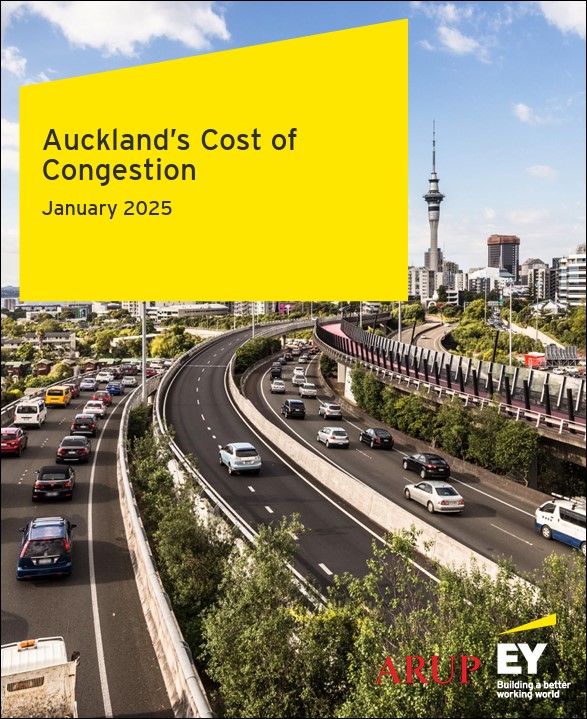Auckland’s cost of congestion
Author:
Arup, EYSource:
Auckland Transport | Arup, EYPublication date:
2025Topics:
TransportFrom the Executive summary:
Auckland’s traffic congestion problem will cost us $2.6 billion a year by 2026. Congestion occurs when a road becomes overcrowded to the point that movement is slow and the flow of cars is limited. This everyday reality has a larger cost than just being late.
Transport modelling suggests that Aucklanders sit in congestion for 29 million hours a year.
In addition, based on international traffic indices, Auckland central is the 77th worst congested city, out of 500 globally (TomTom, Auckland traffic report, 2024).
Auckland’s congestion is driven by high demand for our roading network.
Congestion is caused by a number of different factors, the most direct being when demand exceeds capacity on a given road. Auckland’s demand for its roading network is underpinned by its population and economic growth. Its geography, comprised of dispersed economic hubs in a city that is surrounded by natural constraints, such as the Waitematā and Manukau harbours is also a key factor.
Each of us experiences the cost of congestion…
The time you spend sitting in traffic is time that you are not working, learning, exercising, spending time with friends or family, and relaxing. By 2026, it is predicted that Aucklanders on average will spend over 17 hours stuck in traffic each year (per person, based on 2023 Census data). This is concentrated amongst Aucklanders driving to and from work in the peak periods, but also affects other work-related travel, freight movement, shopping trips, those travelling to and from school / university, and any other travel. Moreover, each additional minute using extra fuel and increasing the wear and tear of your vehicle causes an increase in direct costs. Even if you do not drive a car, the cost of congestion may be experienced on a bus, or through indirect economic costs as a result of overcrowded roads. For example, reduced accessibility can influence housing choices and land use patterns and potentially impact on things like housing affordability.
…It can be felt by our businesses…
As with individuals, businesses bear a cost from congestion. Increased delays, fuel costs, and maintenance expenses increase the challenge of running a business. Tradespeople, truck drivers, and other employees sitting in traffic both contribute to congestion but are also impacted, with implications for commercial costs and the wellbeing of individuals. Labour supply is also disrupted as the costs of travel can make it harder to get to employment hubs. Supply chains face challenges with freight delivery delays and scheduling complications, affecting the steady flow of goods and services. Additionally, the benefits of agglomeration such as knowledge sharing, increased competition, efficient supply chains, and market accessibility can be reduced. For hospitality and retail businesses, ease of accessibility, including things like congestion and parking once you get there, can have material impacts on customer decisions.
…And it’s tough on our planet too.
The vehicles we use daily emit carbon dioxide, nitrous oxide, and particulate matter. These emissions not only degrade air quality and affect our health, but also play a substantial role in greenhouse gas levels. The consequences of these emissions are far-reaching, leading to extreme weather conditions, threats to both biodiversity and marine life, rising sea levels, and an increased risk of severe weather events. Congestion exacerbates this issue by causing traffic flows to break down to stop-start conditions that increase fuel use.
This problem is only expected to get worse.
As Auckland’s population continues to grow, Auckland’s congestion problem is only projected to worsen.
Auckland Transport | Arup, EY
January 2025
See also:
